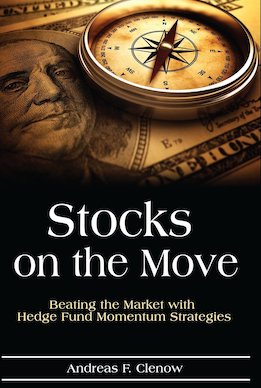 When I see a trading book that should be good I do research on the author as well as the writing before I decide to get it. I had heard about this book from different sources, listened to the author speak on some podcasts, and seen references in the intro to other traders I’ve been following who had helped with the book. Andreas Clenow is a quantitative hedge fund manager and the book is about momentum trading in the US stock market. When I start to read another trading book I don’t expect to learn a bunch of new things, but to understand the thought process and mindset behind the author’s approach to trading the markets in order to generate ideas myself. The book was published in 2015.
When I see a trading book that should be good I do research on the author as well as the writing before I decide to get it. I had heard about this book from different sources, listened to the author speak on some podcasts, and seen references in the intro to other traders I’ve been following who had helped with the book. Andreas Clenow is a quantitative hedge fund manager and the book is about momentum trading in the US stock market. When I start to read another trading book I don’t expect to learn a bunch of new things, but to understand the thought process and mindset behind the author’s approach to trading the markets in order to generate ideas myself. The book was published in 2015.
Being realistic is a good start
The book starts with explaining the mutual fund business and why most managers underperform the index. The author gives a brief introduction to ETFs with a word of caution about derivatives bundled into many exchange traded funds. Andreas brings readers down to earth by explaining why thinking that you can successfully pick stocks on logic and judgement is an illusion, but it’s not to promote technical analysis as he sees a great deal of luck and randomness there, too. He also writes about quantitative strategy simulations and survivorship bias that creeps in if you leave delisted stocks out of the testing universe.
Stocks that have gone up can go even more
It’s funny to read that at the time of writing in early 2015, Apple’s market cap was around $500 billion and the author asked the question, how likely it was for such a large cap stock to double in price compared to small caps. Looking at it today 7 years later, AAPL is worth almost $3T (trillion!). That is 5x return. Though the author has a point that small caps are more likely to double in price than mega caps, it pays to notice that stocks can go up more than it seems logical.
Why classical trend-following doesn’t work on stocks
I like the chapter about classical trend-following and the author saying it doesn’t work on stocks. Not so fast. After ditching the short side that is going short with the trend, the overall performance in his examples improves a lot. This is something I have found out myself after backtesting on decades of data. Simply riding stocks down by holding shorts for the long-term doesn’t work. It may work for a single random example in hindsight, but I mean it doesn’t work statistically on a large sample size. Another point in the book is that trend-following all the stocks in an index long only, doesn’t add any value to just holding the index. Which means we need a way to narrow down the universe of buying candidates and here comes momentum to the game. It may sound too stupid simple to be true, but trading momentum basically means buying stocks that are going up the most, anticipating the move to continue for some time.
Real trading differs from good-looking backtests and simulations
There’s much more in this book about measuring momentum, market filters, position sizing, position rebalancing etc. However, the second part of this piece of writing is rather different but very interesting. The author walks us through the momentum strategy in action that he presented earlier, describing year by year performance since 1999 all the way to 2014 with all the ups and downs and other nuances regarding trading the markets. It’s a fun and eye-opening way of getting explained the daily hustle, randomness and emotions when dealing with the markets in real life. I don’t want to compare the dotcom bubble too much to the most recent euphoria, but I must admit that reading 1999-2000 in action felt so 2020-2021. My main takeaway here was a reminder that as long as one has the discipline to manage risk and follow a tested plan, then feeling stressed about a market move today will look ridiculously unimportant in a 10-year equity curve in hindsight.
Andreas Clenow summarizes his book with just one statement “buy stocks that move up”, but I actually enjoyed reading it even though it covered the topic I have studied a lot before, it still made me think critically about my own strategies and their robustness going forward. If you want to study systematic momentum trading in stocks, then it’s definitely an educative read.
Stocks on the Move by Andreas F. Clenow book link
Share this post